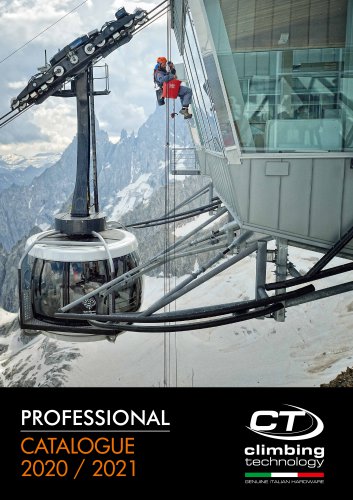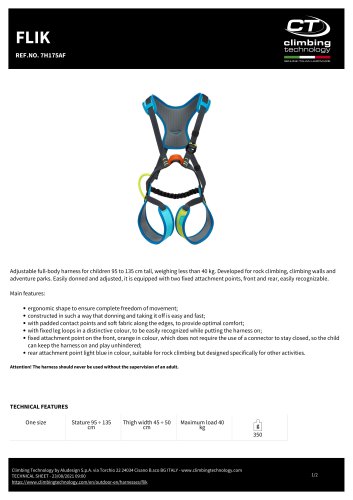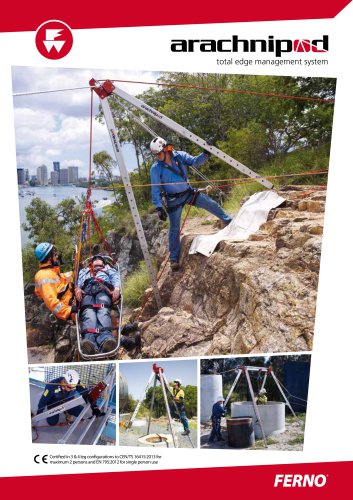 Website:
Climbing Technology
Website:
Climbing Technology
Catalog excerpts

GENUINE ITALIAN HARDWARE
Open the catalog to page 1
YOUR SAFETY PARTNER Climbing Technology (CT) is the brand of Aludesign S.p.A., a company with 31 years of international experience developing and manufacturing Personal Protective Equipment (PPE). CT operate in a factory of 6000 sqm located in Italy, between Bergamo and Lecco, a geographical area characterized by a strong and recognized mountaineering tradition. The extensive know-how, combined with the newest manufacturing technologies, is the prerequisite for the development and production of devices conceived to excel in all vertical activities: mountaineering, sport climbing, work at...
Open the catalog to page 3
INTRODUCTION INTRODUZIONE HARNESSES IMBRACATURE HELMETS AND HEAD-LAMPS CASCHI E LAMPADE FRONTALI LANYARDS CORDINI FALL ARRESTERS AND LIFELINES DISPOSITIVI ANTICADUTA E LINEE VITA RETRACTABLE FALL ARRESTERS AND SELF RETRACTING LANYARDS DISPOSITIVI ANTICADUTA RETRATTILI CONNECTORS AND QUICK-LINKS CONNETTORI E MAGLIE RAPIDE DESCENDERS AND ASCENDERS DISCENSORI, RISALITORI E ACCESSORI TREE CLIMBING RESCUE TRIPODS AND KIT KIT DI SOCCORSO, PARANCHI E TRIPODI PULLEYS CARRUCOLE ANCHORS ANCORAGGI PERMANENTI E TEMPORANEI ROPES CORDE EQUIPMENT EQUIPAGGIAMENTO Climbing Technology archive
Open the catalog to page 5
INTRODUCTION PREMESSA For a long time we have wanted to include in our catalogue a practical explanation of how best to use our products. This is not intended to be a manual nor to substitute a training course, but simply to give a summary of the main activities involved in temporary work at height and rescue fields. For us, safety is a constant, absolute “must”. This attitude drives us to invent, produce and sell products which are safe. A safe product isn’t just one which functions correctly and which meets the legal standards: a safe product is functional, logical, ergonomic,...
Open the catalog to page 7
TEMPORARY WORK AT HEIGHT LAVORO TEMPORANEO IN QUOTA Any activity that exposes the operator to the risk of falling is considered temporary work at height: such a risk must be eliminated or reduced to a minimum by adopting the necessary protection measures, in full compliance with Health and Safety legislation. Protection measures that are used during temporary work at height can be divided into two classes: • collective protection equipment (CPE). Collective protection equipment (CPE). Collective protection is equipment which protects more than one worker from the risk of falling and can...
Open the catalog to page 8
TEMPORARY WORK AT HEIGHT LAVORO TEMPORANEO IN QUOTA RISK ANALYSIS ANALISI E RIDUZIONE DEI RISCHI The risks that can be encountered during temporary work at height may be classified in the following way: A) prevalent risk. The main risk to which the operatory is exposed, that is, the risk of falling from height. B) environmental risks. These “objective” risks are related to the environment, the layout of the site, and the weather conditions: eg risks of objects falling from above, slipperiness of supports, structural failure, collapse of parts not being demolished, uncontrolled working-down,...
Open the catalog to page 9
TYPES OF PPE SYSTEMS SISTEMI DI PROTEZIONE INDIVIDUALE Different PPE devices are assembled together to create systems and subsystems which protect the operator in the event of a fall from a height, preventing or arresting the fall. They can be classified as follows. A restraint system limits the movement of the operator so that s/he cannot reach a zone from which a fall from a height is possible. This system does not arrest a fall, rather, it is designed to prevent a fall taking place. Such a system is not suitable for work situations where the operator needs to be supported by a harness....
Open the catalog to page 10
TEMPORARY WORK AT HEIGHT LAVORO TEMPORANEO IN QUOTA TYPES OF HARNESS TIPOLOGIE DI IMBRACATURE The harness restrains the body and must be worn for temporary work at height. It connects the operator to her/his protection system and, in certain cases, it can hold her/him suspended or during the arresting of a fall. They can be classified as illustrated below. FULL BODY HARNESSES IMBRACATURE ANTICADUTA EN 361 L’imbracatura è un dispositivo di contenimento per il corpo ed è indispensabile indossarla in qualsiasi lavoro temporaneo in quota. Essa consente il collegamento al proprio sistema di...
Open the catalog to page 11
FALL FACTOR FATTORE DI CADUTA The human body can withstand a loading of up to 6 kN without internal injuries being caused. This value is reached when a 100 kg body is accelerated or decelerated at 6 g (1 g = 9,81 m/s2). A deceleration of 6 g is reached, for example, when a fall of 6 m is braked over a distance of 1 m, and this value is used as the maximum the body can withstand and is used in the relevant legislation. The fall factor is a value which describes how dangerous a fall is and is defined as the height lost in the fall divided by the length of the rope (or safety device) that...
Open the catalog to page 12
TEMPORARY WORK AT HEIGHT LAVORO TEMPORANEO IN QUOTA Optimal situation. The anchor point is above the operator, the system connecting the operator and the anchor point is in tension, and a possible fall is arrested immediately. The use of a fall arrester device is advisable, however it is also possible to employ an EN 354 lanyard made with dynamic rope. These lanyards, only in case of fall factor < 0.5, grant an arresting force < 6 kN during the arresting of the fall. Normal situation The anchor point is at the same height as the chest or dorsal attachment point of the EN 361 harness. The...
Open the catalog to page 13
FALL CLEARANCE DISTANCE TIRANTE D’ARIA The “fall clearance distance” is the minimum distance between the operator and the ground needed to guarantee the operator’s safety in the event of a fall. The value of the fall clearance distance depends on the fall arrester device used and it is calculated as the sum of the following distances: A) Total length of the device used, including connectors and any lanyards or extensible arms; B) Rope or cable that runs through the device or extension of the energy absorber during the arresting of the (this value depends on the particular device used and is...
Open the catalog to page 14All Climbing Technology catalogs and technical brochures
-
Catalog PROFESSIONAL 2020 / 2021
196 Pages
-
Catalog OUTDOOR 2021
120 Pages
-
EXPLORER
2 Pages
-
FLIK
2 Pages
-
MOON
3 Pages
-
CLASSIC-K SLIDER
2 Pages
-
Brochure ARACHNIPOD
8 Pages
-
Catalogo PROFESSIONAL 2017
196 Pages
-
Catalogue OUTDOOR 2019
178 Pages
-
Catalog OUTDOOR 2018
196 Pages











